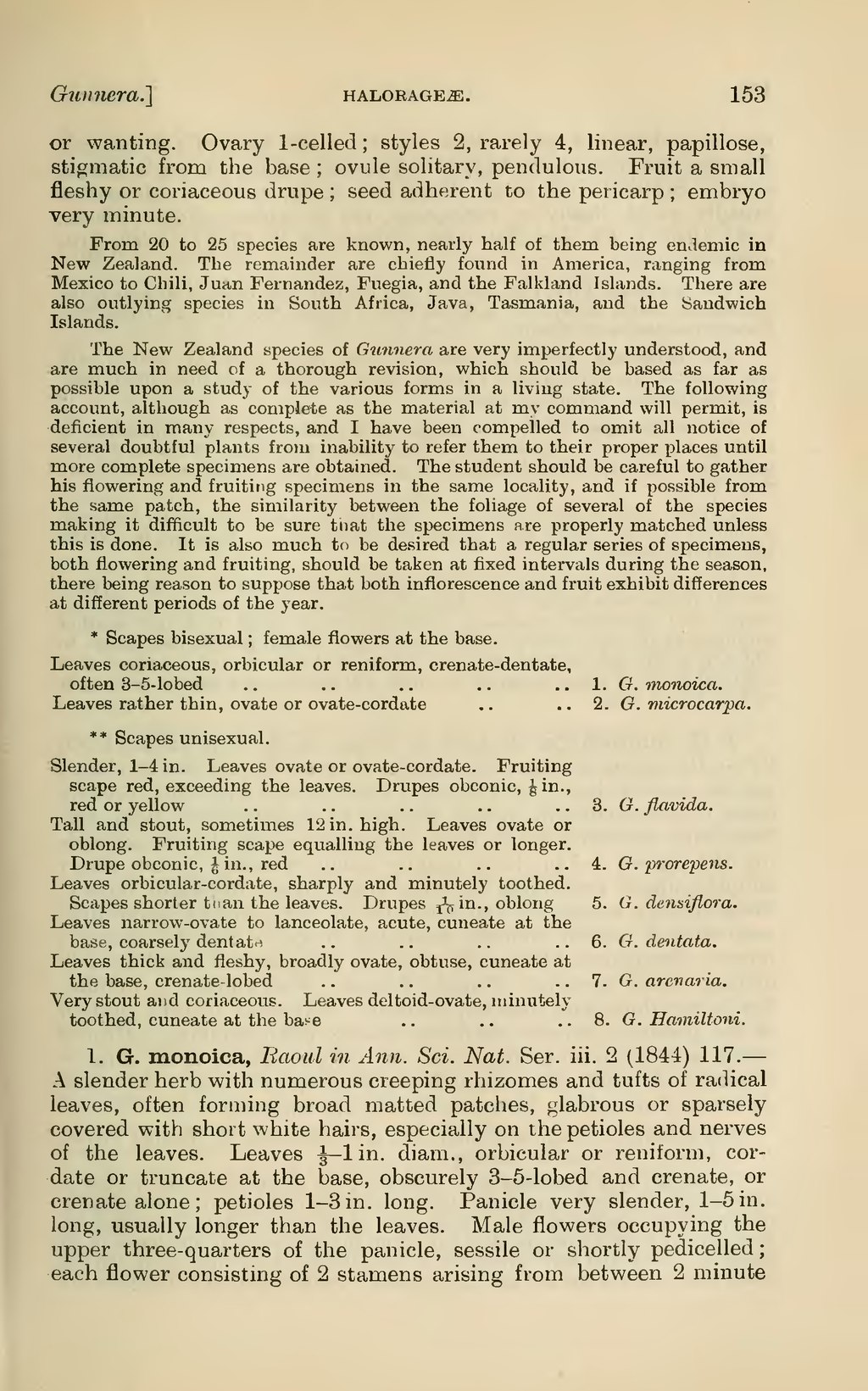or wanting. Ovary 1-celled; styles 2, rarely 4, linear, papillose, stigmatic from the base; ovule solitary, pendulous. Fruit a small fleshy or coriaceous drupe; seed adherent to the pericarp; embryo very minute.
From 20 to 25 species are known, nearly half of them being endemic in New Zealand. The remainder are chiefly found in America, ranging from Mexico to Chili, Juan Fernandez, Fuegia, and the Falliland Islands. There are also outlying species in South Africa, Java, Tasmania, and the Sandwich Islands.
The New Zealand species of Gunnera are very imperfectly understood, and are much in need of a thorough revision, which should be based as far as possible upon a study of the various forms in a living state. The following account, although as complete as the material at my command will permit, is deficient in many respects, and I have been compelled to omit all notice of several doubtful plants from inability to refer them to their proper places until more complete specimens are obtained. The student should be careful to gather his flowering and fruiting specimens in the same locality, and if possible from the same patch, the similarity between the foliage of several of the species making it difficult to be sure that the specimens are properly matched unless this is done. It is also much to be desired that a regular series of specimens, both flowering and fruiting, should be taken at fixed intervals during the season, there being reason to suppose that both inflorescence and fruit exhibit differences at different periods of the year.
| * Scapes bisexual; female flowers at the base. | |
| Leaves coriaceous, orbicular or reniform, crenate-dentate, often 3–5-lobed | 1. G. monoica. |
| Leaves rather thin, ovate or ovate-cordate | 2. G. microcarpa. |
| ** Scapes unisexual. | |
| Slender, 1–4 in. Leaves ovate or ovate-cordate. Fruiting scape red, exceeding the leaves. Drupes obconic, 1/8 in., red or yellow | 3. G. flavida. |
| Tall and stout, sometimes 12 in. high. Leaves ovate or oblong. Fruiting scape equalling the leaves or longer. Drupe obconic, 1/6 in., red | 4. G. prorepens. |
| Leaves orbicular-cordate, sharply and minutely toothed. Scapes shorter than the leaves. Drupes 1/10 in., oblong | 5. G. densiflora. |
| Leaves narrow-ovate to lanceolate, acute, cuneate at the base, coarsely dentate | 6. G. dentata. |
| Leaves thick and fleshy, broadly ovate, obtuse, cuneate at the base, crenate-lobed | 7. G. arenaria. |
| Very stout and coriaceous. Leaves deltoid-ovate, minutely toothed, cuneate at the base | 8. G. Hamiltoni. |
1. G. monoica, Raoul in Ann. Sci. Nat. Ser. iii. 2 (1844) 117.—A slender herb with numerous creeping rhizomes and tufts of radical leaves, often forming broad matted patches, glabrous or sparsely covered with short white hairs, especially on the petioles and nerves of the leaves. Leaves ⅓–1 in. diam., orbicular or reniform, cordate or truncate at the base, obscurely 3–5-lobed and crenate, or crenate alone; petioles 1–3 in. long. Panicle very slender, 1–5 in. long, usually longer than the leaves. Male flowers occupying the upper three-quarters of the panicle, sessile or shortly pedicelled; each flower consisting of 2 stamens arising from between 2 minute

